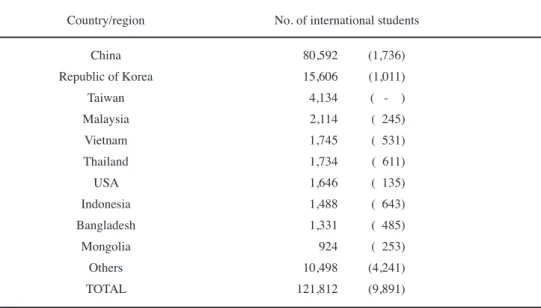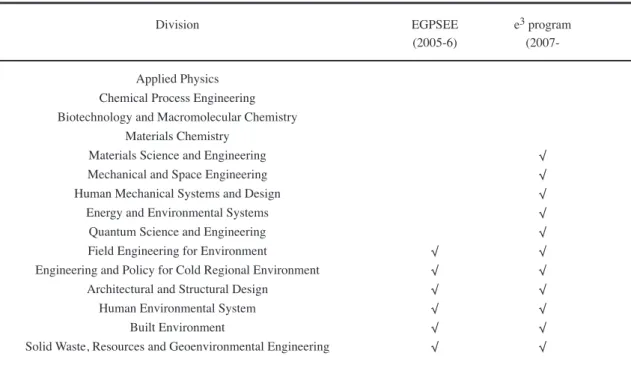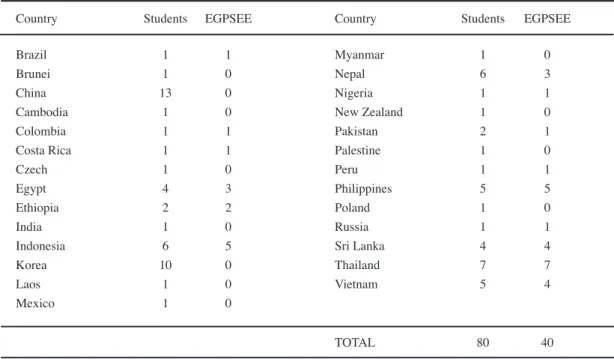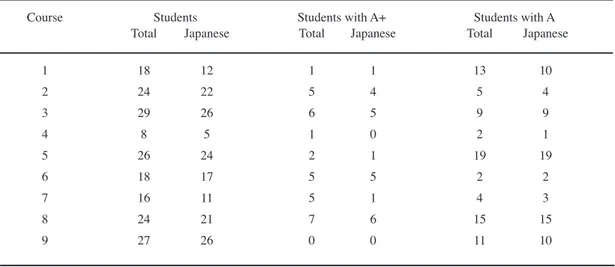Abstract ─ Internationalization is increasingly becoming one of the most important issues in higher education. Adoption of an international language, i.e. English, has been rapidly increasing in uni-versities around the world. When Hokkaido University was established in 1876, its fi rst curriculum was developed by an American professor and all classes were conducted in English. At present the university’s medium of instruction is Japanese and 90% of the international students, who account for 4% of the total student population, attend classes taught in Japanese. The remaining 10% of the international students enroll in the two graduate programs where the medium of instruction is English. Like most Japanese universities, the main reason why Hokkaido University introduced pro-grams in English with the provision of scholarships was to attract excellent international students. At the Graduate School of Engineering, the use of English as a medium of instruction in its graduate program has played an important role in internationalization of the education itself.
(Received on Feburruary 26, 2007)
Role of English in Internationalization of Higher Education:
The Case of the Graduate School of Engineering, Hokkaido University
Werawan Manakul*
Center for Engineering Education Development Graduate School of Engineering, Hokkaido University
1. Internationalization in higher education
As described in the preliminary report of the International Association of Universities (IAU) 2005 Internationalization Survey,
“Internationalization is fast becoming one of the most important and increasingly complex forces of higher education. ... It means different things to different HEIs (higher education institutions), university associations, governments and nongovernmental agencies. For some it means international activities such as study abroad, international development projects, institutional agreements, or branch campuses. For others, it means integrating an international dimension into teaching/ learning, research and service functions of higher education. And still others see it as an international profi le or brand in order to be competitive both domestically and globally. These various perspectives reflect the
fact that there are different rationales driving HEIs to internationalize, bringing a wide range of anticipated benefits and possibly unintended outcomes. HEIs in all regions of the world are addressing the international dimension of higher education in a way that refl ects their values, priorities, opportunities and available resources. Consequently, the internationalization of higher education is a hotbed of activity and a source of potential innovation leading to the development of new policies, programs and practices at institutional, national and international levels.”
Internationalization in higher education in Japan started in the 1980s. Responding to the suggestions made in the OECD report in 1971, in the early 1980s the Japanese government issued policies concerning internationalization of higher education that have since played a major role in the reform of higher education. One of the policies was a plan to host 100,000 overseas students by the year 2000,
which was announced by the Ministry of Education in 1983. To attain the goals, various efforts have been made at both policy and institutional levels. Since then, almost every aspect of the internationalization of higher education has been largely affected by the plan [Huang, 2003]. Starting in the 1990s Japanese higher education has been challenged by the rapid development of globalization. To face the challenges and mounting competition, the government placed more emphasis on such activities as advancement of foreign language teaching and promotion of short-term exchange programs for Japanese students. In 2000, the University Council stressed that enhancement of international aspects and perspectives and the ability to compete at an international level should become the goal of reform in Japanese higher education in this global era. According to the OECD [OECD, 2006], Japan has become one of the most attractive destinations for international students, enrolling about 4% of foreign students worldwide. Thus, it ranks seventh among OECD countries, after the United States (22%), the United Kingdom (11%), Germany (10%), France (9%), Australia (6%) and Canada (5%), and stands ahead of the remaining OECD countries. A closer look shows that 94.3% of foreign students enrolled in Japanese higher education come from Asia, including 64.6% from China and 19.7%
from Korea. Table 1 shows the number of students registered in Japanese universities and professional training colleges, etc.
2. Hokkaido University
As one of the largest and oldest Japanese universities, Hokkaido University prides itself on its basic philosophies of education and research, namely its “Frontier Spirit”, “Global Perspectives”, “All-round Education” and “Practical Learning.” These basic philosophies developed when the university was established in 1876 as Sapporo Agricultural College with a mission to produce graduates needed for the development of the newly occupied island of Hokkaido. During the initial period, classes were taught by foreign faculty members and the medium of instruction was English. Unlike the recent trend where English is used to attract international students, at that time English was used as a tool for Japan to catch up with modernization after the country ended its self-imposed isolation from the outside world.
Hokkaido University accepted its fi rst foreign student in 1902. The student came from China and studied at the university for a period of one month. As of May 2006,
Table 1: International students by country/region (as of 1 May 2005)
Country/region No. of international students
China 80,592 (1,736) Republic of Korea 15,606 (1,011) Taiwan 4,134 ( - ) Malaysia 2,114 ( 245) Vietnam 1,745 ( 531) Thailand 1,734 ( 611) USA 1,646 ( 135) Indonesia 1,488 ( 643) Bangladesh 1,331 ( 485) Mongolia 924 ( 253) Others 10,498 (4,241) TOTAL 121,812 (9,891)
( ) Indicates the number of Japanese government scholarship students Source: JASSO Outline 2006-7
801 international students were enrolled at the university. Students from China, South Korea and Taiwan account for 60% of the total international student population. The main reason for the large number of students from these two countries and the region is the similarities among the three languages that enable them to learn the Japanese language faster than students from other countries. The close proximity in terms of geography and culture can also be considered part of the reason.
Before the introduction of the programs in English at the Graduate School of Agriculture in 1996 and Graduate School of Engineering in 2000, all international graduate students, regardless of the level of their Japanese proficiency, enrolled in the regular graduate programs where Japanese was used as a medium of instruction. Starting in October 2007 the number of special graduate programs for international students increased to four:
• The Special Postgraduate Program in Biosystems Sustainability (previously Agricultural Chemistry, est. 1996) – Graduate School of Agriculture
• English Engineering Education Program or e3
(previously English Graduate Program in Socio-Environmental Engineering, est. 2000) – Graduate School of Engineering
• Special Training Program for Veterinary Researchers toward Building an International Network for Veterinary Researchers (est. 2007) – Graduate School of Veterinary Medicine.
• International Graduate Program in Natural History Science (est. 2007) – Graduate School of Science) With the exception of e3, none of these special graduate programs mentions the word “English” in their program name or website. As the medium of instruction in the undergraduate program is usually Japanese and only one graduate program clearly indicates English as the medium of instruction, it can be said that the university’ s strategic plan to increase the number of foreign students focuses on Japanese-speaking students. This is because the use of Japanese as a medium of instruction does not require any change in the current academic setting and administrative support system.
3. Graduate School of Engineering
The Faculty and the Graduate School of Engineering have the largest number of students, around 4,000, of whom 25% are graduate students and 18% are international students. The English Graduate Program
Table 2: Divisions in Graduate School of Engineering
Division EGPSEE e3 program
(2005-6) (2007-Applied Physics
Chemical Process Engineering Biotechnology and Macromolecular Chemistry
Materials Chemistry
Materials Science and Engineering ✓
Mechanical and Space Engineering ✓
Human Mechanical Systems and Design ✓
Energy and Environmental Systems ✓
Quantum Science and Engineering ✓
Field Engineering for Environment ✓ ✓
Engineering and Policy for Cold Regional Environment ✓ ✓ Architectural and Structural Design ✓ ✓
Human Environmental System ✓ ✓
Built Environment ✓ ✓
in Socio-Environmental Engineering (EGPSEE) was established in 2000 by three Divisions in the Socio-Environmental Engineering Group. It has been allocated 12 Japanese Government or MEXT scholarships annually. The restructuring of the Graduate School in 2005 saw the original three divisions divided into six and the total number of Divisions in the Graduate School of Engineering increased to fifteen. Starting in October 2007 EGPSEE expanded to cover fi ve more divisions and renamed itself the English Engineering Education or e3 program (Table
2). The number of MEXT scholarships allocated to the e3
program has increased by two to 14 scholarships.
4. Increased diversity
Following the establishment of EGPSEE, the number of English speaking students at the Graduate School of Engineering has increased steadily. In fact it can be said that except for students from China and South Korea, most international students at the Graduate School of Engineering are English speaking. Unfortunately they have to enroll in the ordinary Japanese-medium programs since only six of the 15 divisions in the Graduate School joined the English-medium program. As of May 2006, half of the international students at the Graduate School of
Engineering are EGPSEE students (Table 3).
A majority of EGPSEE students do not have any Japanese language background before coming to Japan. Instead they have a TOEFL score of above 550. Due to their lack of Japanese ability all communication with them must be done in English. This has brought about considerable changes in the Graduate School of Engineering. English ability, which did not receive attention in the past, has become prominent and essential. In recruiting faculty members and research-funded administrative staff, one of the basic qualifications required is English ability.
Professors in the EGPSEE can choose to teach the same (or similar) courses in English to international students and in Japanese to Japanese or Japanese-speaking students. Initially six professors who have had experience teaching overseas chose to teach only in English, giving Japanese students no alternative but to attend the same classes with international students. Given the fact that the number of students in the EGPSEE is small in some classes there may be only one student in the class. Having Japanese students in the same class increases the number of students and creates the atmosphere of a real classroom. Some professors believe that active participation by international students can help Japanese students participate more actively in class.
Table 3. Number of international students at Graduate School of Engineering (May 2006)
Country Students EGPSEE Country Students EGPSEE
Brazil 1 1 Myanmar 1 0
Brunei 1 0 Nepal 6 3
China 13 0 Nigeria 1 1
Cambodia 1 0 New Zealand 1 0
Colombia 1 1 Pakistan 2 1
Costa Rica 1 1 Palestine 1 0
Czech 1 0 Peru 1 1
Egypt 4 3 Philippines 5 5
Ethiopia 2 2 Poland 1 0
India 1 0 Russia 1 1
Indonesia 6 5 Sri Lanka 4 4
Korea 10 0 Thailand 7 7
Laos 1 0 Vietnam 5 4
Mexico 1 0
“My class includes Japanese students so the syllabus is the same as for the Japanese course but the quality is much better than the Japanese course I taught before, because EGPSEE students ask many questions. It stimulates the class.
[Japanese professor, 2005]” This professor’s belief is supported by the Japanese students’ opinions. As of May 2005, thirteen Japanese students chose to enroll in the EGPSEE instead of the Japanese medium program. Some of these students told the author that they decided to do so because they wanted to be among enthusiastic international students in order to motivate themselves.
5. Recognition of importance of English
A survey carried out in 2003 among Japanese graduate students in the three divisions that formed the EGPSEE found that most of them recognized the importance of English and 64% did not object to the idea that English be used as the medium of instruction for all the courses at the Graduate School of Engineering [Manakul, 2007]. Their reasons were
• To improve their English ability
• English is necessary for their future work • English ability of Japanese is too poor
• This system is adopted in some universities • They have to concentrate during the class • Overseas lecturers can be invited
• Can attend the class together with international students
• Can learn English technical terms which are necessary
Since April 2005 the Division of Built Environment stopped offering courses in Japanese completely. The Division believes that graduate education should be provided in an international language to prepare students for ever-increasing globalization. This practice is worth observing as the average TOEIC score for Japanese is 454, the lowest in the world [TOEIC, 2005]. At fi rst some faculty members did not support the idea of using English to teach Japanese students. They believed that Japanese students did not have sufficient English proficiency to fully understand the course if taught in English.
Table 4 below shows the number of Japanese students compared to the overall number of students who obtained A and A+ grade in nine English-medium graduate courses taught at the Graduate School of Engineering in 2005. Japanese students were the sole recipients of an A+ grade in two courses (1 and 6) while sharing the grades of A and A+ with international students in the remaining seven courses. Lack of English profi ciency may require Japanese students to pay more attention during the class
Table 4. Number of Japanese students with A+ and A grades in courses taught in English
Course Students Students with A+ Students with A Total Japanese Total Japanese Total Japanese
1 18 12 1 1 13 10 2 24 22 5 4 5 4 3 29 26 6 5 9 9 4 8 5 1 0 2 1 5 26 24 2 1 19 19 6 18 17 5 5 2 2 7 16 11 5 1 4 3 8 24 21 7 6 15 15 9 27 26 0 0 11 10 Note: A+ = 90-100, A = 80=89.
and/or study by themselves more outside the class. Either way the outcome is positive.
At present 81 courses are offered by six divisions that form the EGPSEE. Of these, 41 courses are taught in both Japanese and English, 23 are taught only in Japanese and 17 only in English.
6. Academic standard and quality
The normal practice at most Japanese universities is that international students in the Japanese-medium programs attend Japanese language classes offered by the universities for one semester before enrolling in the degree program.
Low Japanese language ability is the biggest obstacle facing international students who come from countries other than Northeast Asia. It has been estimated that students need 700 hours of formal training to acquire enough Japanese language ability to keep up with university lectures [Tsuneyoshi, 2005]. Therefore the 6-month intensive course offered to newly arrived students prior to their admission to the degree program cannot be considered adequate for most students who enroll in Japanese medium programs.
In his paper [Horie, 2003], Horie cited a report released by the Ministry of Internal Affairs and Communications (Somusho) on the result of a survey of 81 Japanese universities which said that 38% of 272 university professors surveyed thought that the quality of international undergraduate and graduate students has declined. The survey results are shown in Table 5 below. In contrast, international students enrolled in the English medium program have a good command of English since it is one of the requirements for admission.
This enables the students to fully follow the classes and discuss their research. Their inputs during class and feedback after class have indisputably changed the way courses are conducted, making them more in line with the international standard. Since courses taught in English can be compared, through syllabi and course materials, with similar courses taught in different parts of the world, the Quality Assurance Working Group was set up in 2006 to ensure the quality of education provided by the EGPSEE/e3. The fi rst EGPSEE syllabi published in 2000
and the current ones clearly show distinctive differences.
7. Mobility of students and teachers
Hokkaido University has been selected by the Japanese government as one of the 11 Japanese supporting universities under the Southeast Asia Engineering Education Development Network (SEED-Net) Project whose aim is to promote human resources development in engineering in ASEAN and its Graduate School of Engineering is responsible for the civil engineering fi eld. AUN/SEED-Net is mainly supported by the Japanese Government through the Japan International Cooperation Agency (JICA), and partially supported by the ASEAN Foundation.
Using English as a medium of instruction enables the university to take part in the program. All 19 member universities in the ASEAN countries and 11 Japanese supporting universities in the program must provide engineering education in the international language (English). Since its establishment in 2001 four doctoral students from two ASEAN countries joined the program and two more are expected to arrive in 2007. At the same time, through joint research, EGPSEE students conduct
Table 5. Professors’ perception of declining international student quality
Response content Percentage
More students with low Japanese language ability 67 More students who cannot follow class discussions 36 More students who do not attend classes/seminars 25 Declining entrance examination results 20 More students unable to discuss research 12.6 More students dropping out of university 12.6
experiments at universities overseas.
Embarking upon these activities is possible without an English-medium program; however, the existence of an English-medium program gives assurance to the sending universities that their students can fully benefi t from the stay even though the students lack Japanese profi ciency. Moreover, when transfer of credits is involved, all information needed for the evaluation process is available in English.
During the past few years many distinguished foreign professors have been invited to give special lectures and conduct intensive courses. It is true that without an English-medium program foreign professors can still be invited. The fact is that giving a lecture in English to an entire audience without suffi cient English profi ciency can easily discourage invited lecturers, not to mention the extremely small number of those who are “ordered” to attend. Since the Division of Built Environment started offering all its courses only in English, Japanese students have gotten used to lectures in English and some of them even ask questions to invited lecturers -- a practice that is common internationally but is lacking in Japanese universities.
8. International collaboration
The number of collaborative research projects between the Graduate School of Engineering and universities overseas has also increased in recent years partly due to the Center of Excellence (COE) and the AUN/SEED-Net programs. With English speaking students who can directly join discussions on joint research between the collaborating universities and with all research documents available in English, the school is no longer viewed as a national school in a Japanese national university where establishing collaboration is diffi cult due to the language barrier. The Graduate School of Engineering at Hokkaido University has become one of the schools that engineering students worldwide consider applying to to further their studies. For governmental organizations whose policy is development assistance, e.g. JICA, the English medium program in engineering is an ideal solution since human resources can be upgraded quickly and effi ciently.
9. International publications
The number of publications in English and published
EGPSEE, both Japanese and international, are required to publish in English and for doctoral students at least one publication in an international journal. In laboratories where Japanese students study or conduct research jointly with international students, some of these Japanese students voluntarily write their papers in English.
10. Conclusion
Internationalization may mean different things to different people. The author found that the broadest and most all-encompassing definition of internationalization of higher education is the one used in the UNESCO Internationalization of Higher Education 2003 IAU Survey Report. The definition includes mobility and exchanges of students and teachers, teaching and research collaboration, academic standards and quality, research projects, cooperation and developmental assistance, curriculum development, international and intercultural understanding, promotion of the profi le of the institution, diversifi ed sources of faculty and students, regional issues and integration, international student recruitment and diversifi ed income generation.
Is internationalization of a university possible without adopting an international language as a medium of instruction? A century has passed since Hokkaido University accepted its first foreign student and the number of foreign students continues to rise, but internationalization of the university according to the UNESCO defi nition is still far away. However, less than seven years after the introduction of an English-medium program, internationalization has begun to take root at the Graduate School of Engineering. What is described in this article agrees well with the conclusion of Tsuneyoshi [Tsuneyoshi, 2005] that for a country whose language is used only within its boundaries, using English in higher education has certain internationalization effects.
References
Horie, M. (2003), “International Students and Internationalization of Higher Education in Japan: Interpretive Study with Policy Makers and International Educators,” Minneapolis: University of Minnesota
Huang, F. (2006), “Internationalization of Curricula in Higher Education Institutions in Comparative
Netherlands,” Journal of Higher Education 51(4) Manakul, W. (2007), “Enhancing the Graduate
Engineering Education through the English-medium Program,” Ph.D. dissertation, Hokkaido University OECD (2006), “Education at a Glance 2006, OECD
Indicators”
TOEIC Test Data and Analysis (2005)
Tsuneyoshi, R. (2005), “Internationalization Strategies in Japan: The dilemmas and possibilities of study abroad programs using English,” Journal of




